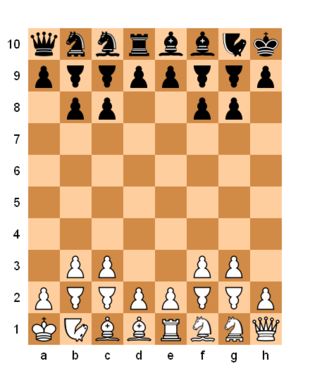
- Chess World Cup
- FIDE Grand Prix
- Olympiad
- World Championship
- List of strong tournaments
- List of world championships

- Checkmate patterns
- Chess openings
- Chess strategy
- Chess tactics
- Chess theory
- Endgames
- Pawn structure
- Problems/Compositions












Wolf Chess is a chess variant invented by Dr. Arno von Wilpert in 1943. It is played on a 10x8 chessboard and employs several fairy pieces including wolf and fox - compound pieces popular in variants and known by different names.
Wolf Chess correspondence matches and tournaments have been held, one of which (Paris vs. Augsburg, September 1960) is claimed to be the first international over-the-board match for a chess variant (Pritchard 1994:343).
 Wolf Chess gameboard and starting position. For this diagram: nightriders are represented by inverted knights; sergeants are represented by inverted pawns. Wolves start on square g1 (for White) and b10 (for Black); foxes start on f1 (White) and c10 (Black).
Wolf Chess gameboard and starting position. For this diagram: nightriders are represented by inverted knights; sergeants are represented by inverted pawns. Wolves start on square g1 (for White) and b10 (for Black); foxes start on f1 (White) and c10 (Black).As in standard chess, White moves first and the winning objective is checkmate. The king, queen, rook, bishops, and pawns move and capture the same as they do in chess. In addition there are some special rules.